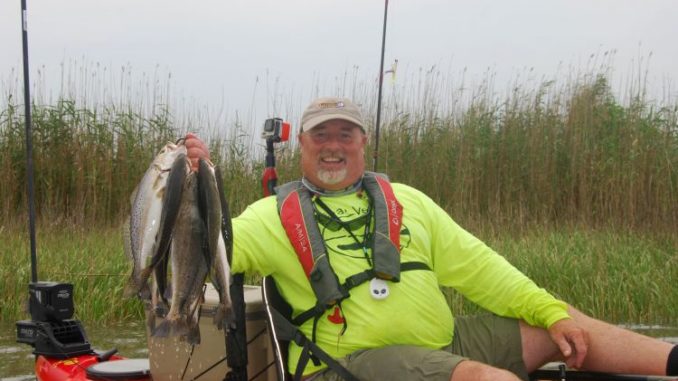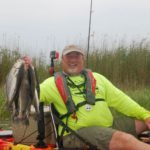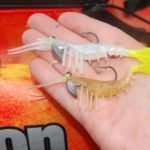
Artificial lures convenient this month for specks and reds, guide says
In a typical kayak, there just isn’t a whole lot of extra room for a vast array of pre-rigged rods, or multiple tackle boxes crammed with an insane variety of hooks, topwater lures, soft plastics and other items you never use but couldn’t pass up during your last visit down the fishing aisle.
For the most part, it’s a minimalist sport — which makes Buras an ideal June location for speckled trout and redfish because of both close paddling proximity, and the ease of using artificial lures this month.
“The artificial bite is definitely on in June,” said Capt. Brian Sherman, who owns and operates Kayak Venice with his 22-year-old son, Nolan. “Take live bait if you can, because sometimes they’re just in that finicky mood. But typically you can catch them good on artificials.”
One of his favorite spots to launch in Buras on the west side of the Mississippi River this time of year is Joshua’s Marina.
“You can catch trout and reds right behind there. You can see the cane poles and the small islands from the launch,” Sherman said. “There’s also a facility on an island about a mile to the right of the marina toward Empire in Drake’s Bay. You can paddle around there and there’s lots of oyster beds out there. And there’s a channel with four canals that come off of it — the mouths of all those canals is where I fish for trout and redfish.”
Topwater lures are a great option on calm days, but Sherman’s go-to lure is definitely a Vudu shrimp, which he uses with a fluorocarbon leader about 2 feet under a cork for both specks and reds. He always uses 30-pound braid, with a 20-pound leader for trout and a 30-pound leader when he’s strictly targeting redfish.
“I keep a Vudu on a rod all day long,” Sherman said. “I start going to the clearer, natural colors when the water is clear. When the water is murky, I’ll use the white-and-chartreuse, and when it’s really dirty, I’ll use the LSU colors and smoke them on it.”
As a kayak guide who can’t simply motor off and cover miles in a matter of minutes to find a new spot, Sherman said it’s important to always remain on the prowl and closely observe the conditions where you’re fishing.
“In a kayak, we’re always moving. I know certain spots where I can usually go and consistently catch fish, but we might have to go back and try some spots when the tide is falling. We go down banks looking for good fish action,” he said. “Usually when you get good fish action in one spot, you have to go a quarter- or a half-mile to where you find good fish action again.”
And just like anglers in gas-powered boats, Sherman is always on the lookout for slicks or diving birds.
“I’ll always go to birds for trout,” he said. “I’ll paddle out there and drift across and maybe pick up 10 or 15 trout with the group, and then we’ll paddle up to where the birds are moving again.
“And I fish slicks as much as I can. Sometimes they’re catfish and sometimes they’re bull reds, but other times it’s trout. So you can never tell. They’re feeding on something, and it’s driving the oil up to the top.”
Pockets of clear water are also something he’s always keeping a watchful eye out for while he’s paddling.
“The clearer the better,” he said. “Fish the breaks where that dirty, muddy water is turning clear. The trout like to hang in that. “But the reds don’t seem to care — they go where there’s food.”
Redfish-wise, Sherman always encourages his clients to keep their popping corks as close to the canes and grass as much as possible.
“Zero to 3 feet from the canes is the strike zone, so I want your bait in there 85 percent of the time,” he said. “The other 15 percent of the time, you might catch a flounder, a drum or a trout further away.”
And in particular, be on the lookout for spots where grass transitions to cane, he said.
“On those grass-to-canes transitions, fish it,” he said. “A lot of times, for some crazy reason, where the vegetation turns, they hang there. And anytime there’s an opening, a trenasse or a dead end, fish them all the time, too.”
Sherman usually only takes along two rods for a trip, one always rigged with the previously-mentioned Vudu shrimp. He keeps his other one set up with a ¼-ounce jighead and either a Gulp or Matrix Shad lure that he uses to sight-fish reds, or to troll with on extended paddles.
“If I know it’s going to be a quarter-mile paddle, I throw a Gulp off the back of the kayak and just drag them,” he said. “And I don’t keep a constant paddle — I paddle erratically when I’m trolling so the lure goes up and down in the water column.”
Sherman, who said he always prefers an incoming tide for trout and an outgoing one for reds, said he never leaves for a kayak trip without his landing net, knife, pliers and Fish Grip.
But he urged all kayak anglers to make a life jacket their No. 1 piece of equipment.
“Too many people are silly about the life jacket. They think because you’re fishing in 3 feet of water that nothing is going to happen,” he said. “You could lose your paddle while a fish is dragging you around. Then what are you going to do? It’s essential, because you just don’t know what kind of silly situation you can get in out there.”
Editor’s Note: For kayak accommodations in Buras, contact Carol LeCompte with Reelivin Charters at 985-791-3334.




